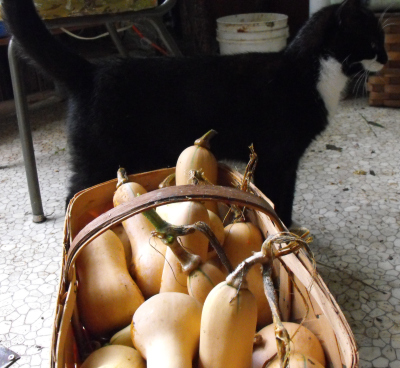
Harvesting and curing butternut squash
 There's nothing that says
"first day of autumn" quite like a heaping basket of winter
squash! People obsessed with appearances grow pumpkins, but folks
who are attached to flavor grow butternuts. You can guess which
camp I fit into....
There's nothing that says
"first day of autumn" quite like a heaping basket of winter
squash! People obsessed with appearances grow pumpkins, but folks
who are attached to flavor grow butternuts. You can guess which
camp I fit into....
You can leave winter squash on the vine until just before the frost,
but our wet weather was starting to rot the fruits so I harvested
early. We got an overflowing peach basket full of squash from our
four plants, which is a bit low due to vine borers,
but not bad.
Unfortunately, I had to cook up over a third of the butternuts
immediately due to nicks and rotten spots. The best way to cook a
butternut is to roast it --- slice each squash long ways, scrape out
the seeds (don't forget to save
some!), and place them cut side down on a baking tray in the oven
to roast until soft. Scoop out the sweet, orange flesh and use it
in butternut
squash soup or turn it into a pie every bit as tasty as pumpkin
pie. (We may try both of these options this week to use up the
nicked fruit.)
The photo above shows the squashes we plan to store for the
winter. I gently rinsed off the mud, cut off bits of vine
attached to stems, and will now let the squash cure for a while at room
temperature. The optimal curing period for winter squash is 10
days at a temperature of 80 to 85 F and a humidity of 80 to 85%.
Our humidity will probably fit the bill, but our temperatures have
already cooled down so that we'll probably have to cure longer.
After curing, I wouldn't be surprised if our butternut squash feed us
all winter --- we gave away a cushaw this month that had been sitting
in our kitchen for nearly a year!
Want more in-depth information? Browse through our books.
Or explore more posts by date or by subject.
About us: Anna Hess and Mark Hamilton spent over a decade living self-sufficiently in the mountains of Virginia before moving north to start over from scratch in the foothills of Ohio. They've experimented with permaculture, no-till gardening, trailersteading, home-based microbusinesses and much more, writing about their adventures in both blogs and books.
Want to be notified when new comments are posted on this page? Click on the RSS button after you add a comment to subscribe to the comment feed, or simply check the box beside "email replies to me" while writing your comment.
